Find the best dermatologist to address your dermatology needs.
Navigating Skin Cancer Treatment: The Vital Duty of Mohs in Modern Dermatology Practices
Skin cancer cells, a challenging medical diagnosis, often leaves patients grappling with numerous therapy choices. As we explore the ins and outs of this procedure, one will certainly value its critical duty in skin cancer cells therapy.
Recognizing Skin Cancer Cells: Kinds and Dangers
Skin cancer, a possibly life-threatening condition, is even more common than many individuals realize. This condition, created by the unchecked growth of uncommon skin cells, primarily arises from DNA damages due to direct exposure to the sunlight and ultraviolet (UV) light. There are 3 primary types of skin cancer cells: Basal cell cancer, Squamous cell cancer, and Cancer malignancy. While the previous two are much less dangerous and compose most of identified cases, cancer malignancy is one of the most dangerous. It accounts for just regarding 1% of skin cancer situations yet causes the huge bulk of skin cancer cells fatalities - chemical peel. Threat factors include reasonable skin, history of sunburn, too much sunlight direct exposure, living at high elevations or shut to the equator, having several moles, a household history of skin cancer cells, and damaged body immune system.
What Is Mohs Surgical treatment and How It's Transforming Skin Cancer Therapy
Regardless of the countless treatments currently readily available for skin cancer cells, Mohs surgical procedure stands out as a groundbreaking and very effective solution. Named after Frederic E. Mohs, the physician who developed the treatment, Mohs surgical procedure is a precise medical method used to treat skin cancer cells. During the treatment, thin layers of cancer-containing skin are progressively eliminated and checked out until only cancer-free tissue stays. This technique permits the cosmetic surgeon to verify that all cancer cells have actually been eliminated at the time of surgical treatment. This level of accuracy, combined with the capacity to spare as much healthy and balanced cells as feasible, is transforming skin cancer cells hop over to these guys treatment. Therefore, Mohs surgical procedure has come to be a cornerstone of modern dermatology techniques.
The Advantages of Mohs Surgical Procedure Over Standard Skin Cancer Therapies
Building on the cutting-edge nature of Mohs surgical treatment, it's critical to consider its countless advantages over typical skin cancer cells therapies. Unlike common treatments, Mohs uses a higher treatment rate, frequently reaching 99% for new therapies and 94% for recurrent cancers cells. This precision is because of its unique method of considerably removing and taking a look at cells layers until just cancer-free cells remain (hair loss). Furthermore, it minimizes damage to healthy and balanced skin, bring about less scarring and improved cosmetic results. Mohs additionally offers immediate results, removing browse around here the anxiety-ridden wait usual with other techniques. It's cost-efficient, as the surgical procedure and tiny exam happen concurrently, getting rid of the demand for added lab services. Thus, Mohs represents a substantial improvement in skin-related techniques.
The Procedure of Mohs Surgery: What to Anticipate During the Refine

Prospective Negative Effects and Post-Operative Treatment of Mohs Surgical Procedure
Undergoing Mohs surgical procedure, like any kind of other operation, includes possible side results that individuals must know. Usual side effects include discomfort, wounding, and swelling at the surgical treatment site. These are typically momentary and manageable with over-the-counter pain medicine and ice packs. In unusual cases, individuals may experience infection, blood loss, or a sensitive response to the anesthetic. Post-operative treatment is vital to healing and decreasing adverse effects. This usually entails keeping the wound tidy and dry, taking proposed medications, advice and avoiding exhausting activities. Individuals must additionally attend all follow-up consultations for wound treatment and surveillance. Sometimes, additional therapies may be essential to ensure complete removal of the malignant cells. Sticking to these post-operative treatment guidelines can significantly boost healing and results.
Conclusion
